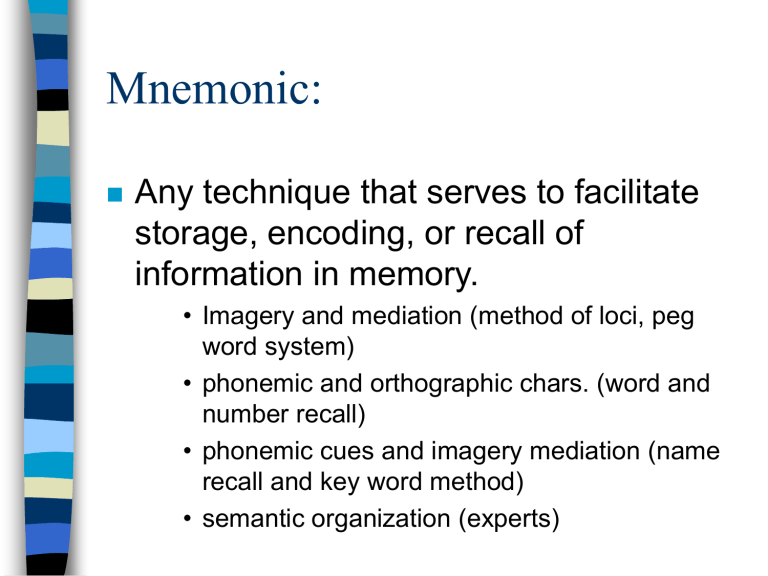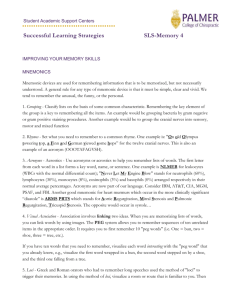Chapter 6 Power Point

Mnemonic:
Any technique that serves to facilitate storage, encoding, or recall of information in memory.
• Imagery and mediation (method of loci, peg word system)
• phonemic and orthographic chars. (word and number recall)
• phonemic cues and imagery mediation (name recall and key word method)
• semantic organization (experts)
Method of Loci
Loci are locations such as a door, closet or driveway. The method can be used in
3 steps:
– First identify the Loci and arrange them in a familiar sequence.
– Create images of the to be recalled (TBR) items that are then associated with the
Loci.
– Finally recall by mentally "revisiting" the places or Loci which will cue the TBR items.
S
S.'s Capabilities:
– Was able to recall without error a list of words that was increased from 30, 50, and then to 70.
– Several months later was able to recall the list as accurately as on the first occasion.
– Performed numerous experiments did not seem to forget words, even if the syllables were nonsense syllables. He would remember them for days, months or even years.
Peg word systems:
Mnemonic strategy which involves learning a set of stimulus items that are
"pegs" on which items to be remembered are hung.
– This technique involves some organization.
• first memorize some words of which I could hang other words I needed to remember later.
• This is kind of like the method of loci, except instead of using landmarks you use pegs in the form of words.
peg word system...
is like hanging your coat up on a rack by the door.
First, a person would remember a list of peg words rhyming with a number like:
– one: bun
– two: shoe
– three: tree
– four: door
– five: drive
peg word system...
Next the person would "hook" each word to be memorized to a peg and associate the two in a bizarre image.
The more bizarre, the better the effect on memorizing.
– Remember cheese, vacation, and song:
– think of some cheese between those buns.
– Then for vacation, envision the tickets for vacation are in your shoe.
– I would picture Elvis singing a song in a tree.
Organizational schemes
a mnemonic method in which a list is organized into a smaller group of related items by color, shape, place, sound, etc.
Additional Techniques...
Acronym: HOMES
Acrostic Every Good Boy Does Fine
Recall of Name
Step one: Pay close attention to the person's name and its pronunciation.
Step two: Form a substitute name or phrase.
Step three: Choose an outstanding feature of the person like receding hairline, portly frame, large mouth, hot body. ..
Step four: Tie the substitute name with the feature.
Which Is Best?
Herrmann (1987) found:
– paired associate learning - imagery mediation
– free-recall learning - story mnemonic
– serial learning - method of loci
Expertise
Experts have greater knowledge than novices and tend to organize their knowledge in terms of general principles rather than in terms of surface features.
– For example, An expert chess player is said to have about 50,000 patterns in memory; a good player about 1000 moves; and a novice, only a few.
Expert system:
An expert system is a system that comes to a conclusion by using a data base of knowledge.
– An example would be a computer program you would want to use to learn what is wrong with your car. The expert system would ask you questions and from your answers come up with a conclusion using it's vast knowledge on cars.
Expertise
Chase and Ericsson (1982) have explained extraordinary memory operations in terms of three principles that account for skilled memory and how experts “exploit” their long term memory to perform unusual tasks.
Chase and Ericsson (1982)
1. The mnemonic encoding principle
(organization)
– experts encode information in terms of a large existing knowledge base.
• In memorizing a large number if digits for example, one expert, a long distance runner, used "good times" for a one-mile run, a marathon, a 3-k run, and so on to remember various chunks of digits.
• Is his short term memory larger? Probably not.
Chase and Ericsson (1982)
2. The retrieval structure principle
(access)
– experts use their knowledge of a subject to develop abstract, highly specialized mechanisms for systematically encoding and retrieving meaningful patterns from long term memory.
– This ability allows experts to anticipate the informational needs of a familiar task and to store new information in a format that will facilitate its retrieval.
Chase and Ericsson (1982)
3. The speed-up principle (speed)
– Practice increases the speed with which experts recognize and encode patterns.
– Experts are also able to retrieve information from long term memory more quickly than novices.
• If long term memory storage and retrieval are facilitated with extensive practice, then the extent to which new information can be processed is seemingly unlimited.
Characteristics of Experts
summary of research findings
Experts excel in their own domains
experts perceive large meaninful patters in their own domain
Experts are fast
Experts utilize STM and LTM effectively
Experts see and think about problem at deeper level
Spend more time thinking about a problem
Importance of Practice
Practice Practice Practice Practice
Practice Practice Practice Practice
Practice…
Intelligent practice is most definitely related to expertise!
– People can be trained to become experts, not something you “have” or “don’t have”!
Summary of Expertise
Expertise is accomplished thru: organization of material access to knowledge base speed of encoding practice




